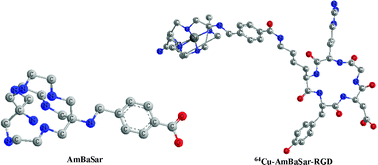Synthesis of a novel bifunctional chelator AmBaSar based on sarcophagine for peptideconjugation and 64Cu radiolabelling†
Abstract

* Corresponding authors
a
Molecular Imaging Center, Department of Radiology, Keck School of Medicine, University of Southern California, Los Angeles, CA, USA
E-mail:
pconti@usc.edu
Fax: +1 323-442-5778
Tel: +1 323-442-5940

 Please wait while we load your content...
Something went wrong. Try again?
Please wait while we load your content...
Something went wrong. Try again?
H. Cai, J. Fissekis and P. S. Conti, Dalton Trans., 2009, 5395 DOI: 10.1039/B902210D
To request permission to reproduce material from this article, please go to the Copyright Clearance Center request page.
If you are an author contributing to an RSC publication, you do not need to request permission provided correct acknowledgement is given.
If you are the author of this article, you do not need to request permission to reproduce figures and diagrams provided correct acknowledgement is given. If you want to reproduce the whole article in a third-party publication (excluding your thesis/dissertation for which permission is not required) please go to the Copyright Clearance Center request page.
Read more about how to correctly acknowledge RSC content.
 Fetching data from CrossRef.
Fetching data from CrossRef.
This may take some time to load.
Loading related content
